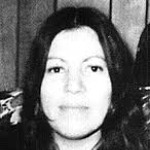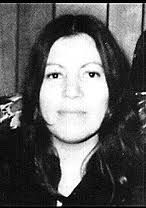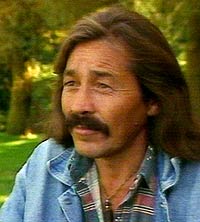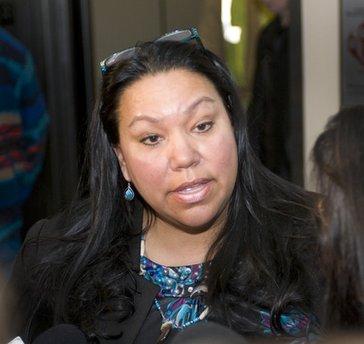Three Decades Later: Justice for Murdered Activist
 35 years after she was murdered -- shortly before Christmas 1975 -- Indian activist Anna Mae Aquash may finally have found justice.
35 years after she was murdered -- shortly before Christmas 1975 -- Indian activist Anna Mae Aquash may finally have found justice.
Almost exactly 35 years after she was murdered shortly before Christmas, 1975, justice has finally been done for Anna Mae Aquash – or has it?
In a South Dakota courtroom, John Graham, 55, a Tsmishian Indian from Yukon, was found guilty of “felony murder” this month in Anna Mae’s death, while his co-murderer, Arlo Looking Cloud, was found guilty of first degree murder in 2004. Both were sentenced to life in prison. “Felony murder” (in some states) is akin to manslaughter.
Graham was extradited from Vancouver, where he had a large network of supporters who believed in his innocence. His lawyer called no witnesses at his trial, yet the jury took 12 hours and repeated motions to the judge, before finding him guilty. Looking Cloud’s verdict took barely two hours.
Leonard Peltier, a Chippewa-Sioux, has spent some 33 years in prison, charged in the 1975 death of two FBI agents during a range war on South Dakota’s Pine Ridge Reserve.
Peltier knew both Graham and Looking Cloud, and feels Graham has been railroaded. In a letter to me, Peltier says he thinks Looking Cloud is “a lying a- -hole… who is screwed up in his head.” Peltier, himself, is a victim of the U.S. justice system. An appeals court judge (Gerald Heaney) once urged President Reagan to commute his sentence due to irregularities and perjury by the FBI at his trial in 1976. No dice. Peltier is convinced he will die in prison.
img class="size-full wp-image-61605 " title="arlo-looking-cloud" src="http://www.frumforum.com/wp-content/uploads/2010/12/arlo-looking-cloud1.jpeg" alt="" width="300" height="485" /><
Arlo Looking Cloud
The story of Anna Mae, a Mi’kmaq Indian from Nova Scotia, reflects well on no one — especially not the Canadian government which, over the years, not only showed little interest in discovering the truth of Anna Mae’s murder, but resisted acknowledging her murder.
Anna Mae was an activist with the American Indian Movement (AIM) during the 71-day siege at Wounded Knee in 1973, and later at the Lakota Pine Ridge range war in South Dakota.
In those days, the FBI had a bee in its bonnet that AIM was a subversive terrorist organization, manipulated by Soviet intelligence or propaganda.
Agents tried to recruit Anna Mae as an informer. When she rejected them, they threatened to plant the suspicion among the paranoid leaders of AIM that she was an informer.
This is precisely what happened. Peltier recalls the woman who later turned out to be working for the FBI, insisting that Anna Mae was “an FBI snitch.” In 1975 Anna Mae ran for her life.
As it turned out, two young Indian wannabes, eager to gain warrior status, kidnapped her in Denver, Colorado, and transported her across state lines (a federal crime) to the badlands of the Dakotas.
Roughly two weeks before Christmas in 1975, the young men had Anna Mae kneel down, say prayers, then shot her in the back of the head. Her partly decomposed body was found two months later.
The FBI agent who had tried to recruit her, David Price, failed to identify her body so she was buried as Jane Doe in an unmarked grave. Her hands were amputated and sent to Washington for fingerprint identification. An autopsy ruled death from exposure.
Anna Mae’s family and others disbelieved the official reports when they came in. They had her grave exhumed. Their own medical examiner found that exposure wasn’t the cause of death. A bullet fired in the back of her head was lodged under the skin beneath her eye.
For decades the mystery prevailed, with AIM accusing the FBI, and vice-versa. Individuals were quick to blame others with whom they had leadership problems. It was in the midst of this that Leonard Peltier was blamed for the shooting death of two FBI agents who were raiding the reserve at Pine Ridge. Peltier fled to Canada and was later extradited on admittedly perjured testimony.
During the range war at Wounded Knee and Pine Ridge, some 60 people were killed, few of which were ever investigated.
Wounded Knee is deeply symbolic for Lakota Sioux. In 1890, the U.S. 7th Cavalry – George Custer’s regiment that was annihilated at the Little Big Horn in 1876 – attacked Wounded Knee and slaughtered some 150 -- mostly women and children. Shamefully, 20 Congressional Medals of Honor were awarded.
After Pine Ridge, AIM settled down into being a more conventional Indian rights movement. Anna Mae’s murder was put on the back-burner.
Her family and her two daughters in Nova Scotia sought to keep her memory alive, but no one in Ottawa was interested. After serving as Liberal solicitor general, Warren Allmand, to his credit, argued passionately on Peltier’s behalf. Too little, too late.
Debbie Pictou Maloney
In the mid-1990s Anna Mae’s cousin, Robert Pictou Branscombe became interested in the case and traveled America interviewing those who knew her. He turned up details the police missed, and gradually focused on John Graham and Arlo Looking Cloud.
It was also a persistent detective in Denver, Abe Alonzo, who kept digging into Anna Mae’s kidnapping when others had given up. Alonzo also dug up evidence that pointed to Looking Cloud and Graham.
In 2004, Arlo Looking Cloud went on trial in Rapid City, S.D., for Anna Mae’s murder. He was found guilty and sentenced to life.
The U.S. applied to have John Graham extradited from Canada. Various John Graham defense committees argued that he was the wrong man. They failed. Graham even partially confessed.
At his trial, his lawyer called no witnesses. Looking Cloud testified against him, and the jury found Graham guilty of felony murder (manslaughter) almost 35 years to the day that Anna Mae had been shot in the Dakota badlands, and left mortally wounded to crawl into a gulley and die.
And for what? She betrayed no one, was a victim of hyper-suspicions and possibly the FBI falsely leaking that she was an informer.
A few years ago Anna Mae’s remains were returned to Nova Scotia for burial, and a memorial was erected in her name. There’s also one at Wounded Knee.
At the trial were Anna Mae’s daughters—Denise Maloney Pictou, and Debbie, who today is a corporal in the RCMP. While John Graham’s supporters feel he was railroaded, Anna Mae’s daughters have no doubts.
They finally have closure, and feel justice has been done in their mother’s name -- with no thanks to Canada, which turned its back and ignored the injustice.




